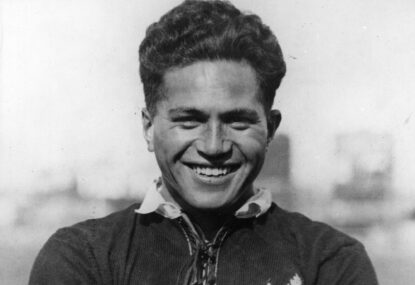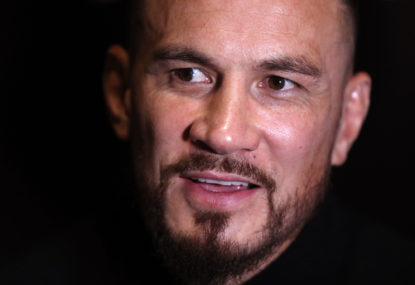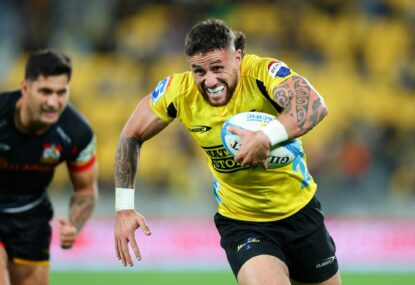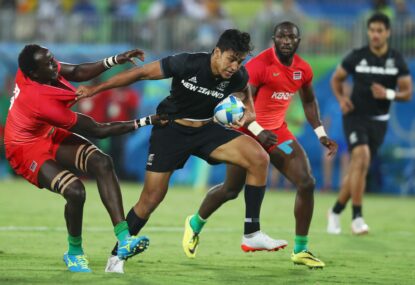On the 27th November, 2004, Graham Henry would take his first year All Blacks to the Stade de France in Paris and begin a remarkable period of dominance with a 45-6 win over Les Bleus.
Not just any Les Bleus, but the Six Nation’s Grand Slamming Tri Colours.
It would be the birth of a fearsome All Blacks team, that would carry all before them right through to the World Cup in France, losing just four matches from the end of 2004 through to the end of 2007.
In 2005, after the Crusaders had just won the final season of the Super 12 – before it was expanded to the Super 14 – two men would emerge as pillars on which the All Black team would be built and, if anything, would become almost too valuable to the New Zealand rugby setup.
Richard Hugh McCaw and Daniel William Carter.
The All Blacks would open their 2005 international campaign by inflicting the heaviest test defeat on Fiji 91-0.
It would appear to be an almost unsuitable warm-up for Clive Woodward’s comprehensively prepared British and Irish Lions squad, arriving with enough support team and management to run a national union.
It would count for little.
The All Blacks would whitewash the fabled touring side 3-0 with an aggregate score line of 107-40, the worst series defeat ever suffered in over a century of the celebrated team’s history.
They would then go on to win the Tri Nations. From this year to 2008, New Zealand would win all of the Southern Hemispheres premier titles, winning 15 matches and losing just five.
They would also win the Bledisloe Cup for the third straight year; and embark on the second longest Tran-Tasman reign in the Cup’s 78 year history.
Over this time the All Blacks would win 12 matches against the Wallabies and lose only three.
Grand Slams, a world record 26 match home winning streak, and a 15 match undefeated run against the Northern Hemisphere would cap what would be a remarkable run for the All Blacks, whose only blemish would be a loss in Cardiff against France on the 6th October 2007.
There are key differences between this current All Blacks team and the all powerful side that swept all before them in a golden period in 2005, 2006, 2008 and, for the most part, 2007.
Let’s look at the discrepancies from the front.
In the front row Carl Hayman was an immense rock in which the All Blacks built so much in their first phase possession.
The reality is that the tighthead was the best in the world at his craft, and New Zealand has struggled to replace him.
Also, stalwarts Greg Somerville and Anton Oliver, the former an All Black captain, are no longer part of the national setup.
In the locks, Chris Jack, Norm Maxwell, James Ryan and Keith Robinson have moved on.
While the former currently plays for Western Province and will return to New Zealand, in the second row, the All Blacks have struggled to unearth test quality locks; despite the emergence of Isaac Ross.
In the flanks, both McCaw and So’oialo remain, but the man who was counted as arguably the most intimidating player in world rugby has since moved to France.
Jerry Collins was the perfect foil for his fellow loose forwards, who captained the test team and was at his peak the best blindside in world rugby.
The All Blacks have not had such a hard man in the loose or on defence since.
In the halves, Byron Kelleher was, before moving to Toulon, considered one of the premier classic “ninth forward scrumhalves” and constantly had competition from players such as Piri Weepu and, more recently, Brendan Leonard.
This was the key of this era.
No player (perhaps with the exception of McCaw and Carter) was safe. There was constant competition between players and the All Blacks could – and did – in theory rotate their entire starting XV without weakening their test side.
But there was another tactical difference between the current hybrid and the All Black teams of recent years past.
At second five eighth.
Ma’a Nonu is an explosive player, an intimidating ball carrier and strong line breaker – no doubt at his best an automatic inclusion.
However, he is more of an inside centre, rather than an archetypal second five eighth that has been a hallmark of the New Zealand game.
Aaron Mauger and Luke McAlister served this role, and while Nonu certainly has traits that are desirable to a rugby team, have the All Blacks lost a strategic aspect of their play without the backup playmaker position at second receiver?
Finally, there was one last variance between the team of yesteryear and now.
That team was young, hungry, and keen to impart themselves on both the world stage and the history books – which they did.
The World Cup aside, this current team is playing second fiddle to a Springbok team that sees more opportunity to make their mark on the annals of our great game.
Can this team rediscover that yearning? Or are the All Blacks trapped in a transitional phase that may only be broken in 2011?


































































































